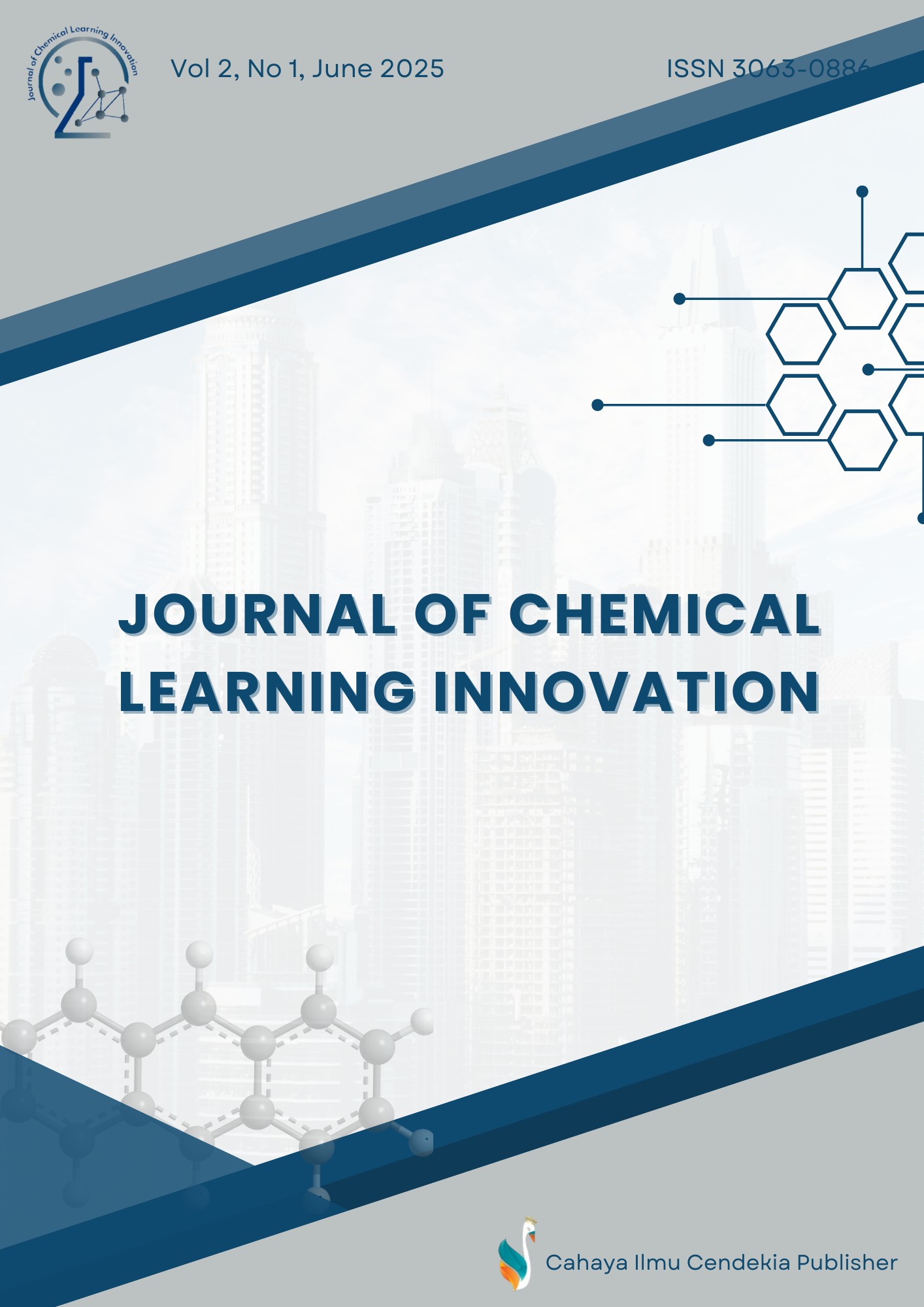Practical Spectrophotometry: Exploring Maximum Absorption Peaks of Fe(SCN)₃ and CuSO₄ Solutions Using Visible Light
Abstract
Purpose of the study: This study explores simple visible light spectroscopy to measure maximum absorption wavelengths in Fe(SCN)₃ and CuSO₄ solutions, analyzing the impact of light filters on absorption spectra.
Methodology: This study exposed Fe(SCN)₃ and CuSO₄ solutions to tungsten lamp light, passing through a collimator and diffraction grating. Spectral data, recorded by a camera, compared filtered and unfiltered conditions. Absorbance, determined from light intensity differences, revealed characteristic wavelengths with maximum absorbance for each solution, visualized through wavelength-absorbance graphs.
Main Findings: The maximum absorption wavelengths for Fe(SCN)₃ were 481 nm (with filter) and 472 nm (without filter), while for CuSO₄, they were 570 nm (with filter) and 553 nm (without filter). Monochromatic filters enhanced accuracy, aligning Fe(SCN)₃ closer to theoretical values and reducing CuSO₄ deviations to 20 nm (filtered) compared to 37 nm (unfiltered).
Novelty/Originality of this study: The novelty of this study lies in the development of a simple visible light-based spectrophotometer by utilizing easily accessible tools and materials, such as tungsten lamps and CMOS cameras, to understand the maximum absorption peaks of Fe(SCN)₃ and CuSO₄ solutions. In addition, this study explores the effect of using light filters on the accuracy of spectrum data, providing a practical alternative for spectroscopy experiments in resource-limited learning environments.
References
M. A. Carpentieri, G. Fano, S. Jurinovich, and V. Domenici, “Introduction to Light Properties and Basic Principles of Spectroscopy at the High-School Level: A Pilot Study,” Educ. Sci., vol. 13, no. 3, pp. 1–22, 2023, doi: 10.3390/educsci13030316.
A. Orlando et al., “A Comprehensive Review on Raman Spectroscopy Applications,” Chemosensors, vol. 9, no. 9, pp. 1–28, Sep. 2021, doi: 10.3390/chemosensors9090262.
J. Cheng et al., From VIB- to VB-Group Transition Metal Disulfides: Structure Engineering Modulation for Superior Electromagnetic Wave Absorption, vol. 16, no. 1. Springer Nature Singapore, 2024. doi: 10.1007/s40820-023-01247-7.
S. Kim, S. Lee, Y. Zhang, S. Park, and J. Gu, “Carbon‐Based Radar Absorbing Materials toward Stealth Technologies,” Adv. Sci., vol. 10, no. 32, pp. 1–12, Nov. 2023, doi: 10.1002/advs.202303104.
Y. Qi et al., “Deciphering dissolved organic matter by Fourier transform ion cyclotron resonance mass spectrometry (FT-ICR MS): from bulk to fractions and individuals,” Carbon Res., vol. 1, no. 1, pp. 1–3, Jun. 2022, doi: 10.1007/s44246-022-00002-8.
G. Visconti, J. Boccard, M. Feinberg, and S. Rudaz, “From fundamentals in calibration to modern methodologies: A tutorial for small molecules quantification in liquid chromatography–mass spectrometry bioanalysis,” Anal. Chim. Acta, vol. 1240, pp. 1–18, 2023, doi: 10.1016/j.aca.2022.340711.
A. B. D. Nandiyanto, R. Ragadhita, and M. Aziz, “How to calculate and measure solution concentration using uv-vis spectrum analysis: Supporting measurement in the chemical decomposition, photocatalysis, phytoremediation, and adsorption process,” Indones. J. Sci. Technol., vol. 8, no. 2, pp. 345–362, 2023, doi: 10.17509/ijost.v8i2.57783.
Y. M. Hunge et al., “Visible Light-Assisted Photocatalysis Using Spherical-Shaped BiVO4 Photocatalyst,” Catalysts, vol. 11, pp. 1–11, 2021.
B. Liu, J. Cai, J. Zhang, H. Tan, B. Cheng, and J. Xu, “Simultaneous benzyl alcohol oxidation and H2 generation over MOF/CdS S-scheme photocatalysts and mechanism study,” Chinese J. Catal., vol. 51, pp. 204–215, Aug. 2023, doi: 10.1016/S1872-2067(23)64466-3.
V. H. Nguyen, A. L. H. Pham, V.-H. Nguyen, T. Lee, and T. D. Nguyen, “Facile synthesis of bismuth(III) based metal-organic framework with difference ligands using microwave irradiation method,” Chem. Eng. Res. Des., vol. 177, pp. 321–330, Jan. 2022, doi: 10.1016/j.cherd.2021.10.043.
Z. Shi, C. W. K. Chow, R. Fabris, J. Liu, and B. Jin, “Applications of Online UV-Vis Spectrophotometer for Drinking Water Quality Monitoring and Process Control: A Review,” Sensors, vol. 22, no. 8, pp. 1–21, Apr. 2022, doi: 10.3390/s22082987.
H. S. Elbordiny, S. M. Elonsy, H. G. Daabees, and T. S. Belal, “Sustainable quantitative determination of allopurinol in fixed dose combinations with benzbromarone and thioctic acid by capillary zone electrophoresis and spectrophotometry: Validation, greenness and whiteness studies,” Sustain. Chem. Pharm., vol. 27, p. 100684, Jun. 2022, doi: 10.1016/j.scp.2022.100684.
N. Monarumit, T. Lhuaamporn, D. Schwarz, P. Wathanakul, and W. Wongkokua, “An application of polychromatic UV-Vis-NIR spectroscopy on detection of beryllium treatment in ruby and yellow sapphire,” J. Phys. Conf. Ser., vol. 2653, no. 1, pp. 1–6, 2023, doi: 10.1088/1742-6596/2653/1/012011.
A. A. Abdelaziz, P. S. Ismail, and D. E. Mohamed, “COMPARATIVE EVALUATION OF SHADE MATCHING USING A DIGITAL SPECTROPHOTOMETER IN MONOCHROMATIC VERSUS POLYCHROMATIC LAYERING TECHNIQUES FOR RESTORING FRACTURED INCISAL ANGLES OF MAXILLARY INCISORS :,” Egypt. Dent. J., vol. 71, no. 2, pp. 1785–1800, 2025.
M. Maafi, “On photokinetics under polychromatic light,” Front. Chem., vol. 12, no. April, pp. 1–25, 2024, doi: 10.3389/fchem.2024.1367276.
A. Bierman, K. Benner, and M. S. Rea, “Melanin bias in pulse oximetry explained by light source spectral bandwidth,” Br. J. Anaesth., vol. 132, no. 5, pp. 957–963, 2024, doi: 10.1016/j.bja.2024.01.037.
M. Xi, H. Liu, D. Li, and Y. Wang, “Intensity response model and measurement error compensation method for chromatic confocal probe considering the incident angle,” Opt. Lasers Eng., vol. 172, p. 107858, Jan. 2024, doi: 10.1016/j.optlaseng.2023.107858.
D. Xu et al., “Design of a digital tunable stellar spectrum calibration source based on a digital micromirror device,” Measurement, vol. 191, p. 110651, Mar. 2022, doi: 10.1016/j.measurement.2021.110651.
L. G. Pap, “An Inexpensive 3D-Printable Do-It-Yourself Visible Spectrophotometer for Online, Hybrid, and Classroom-Based Learning,” J. Chem. Educ., vol. 98, no. 8, pp. 2584–2591, Aug. 2021, doi: 10.1021/acs.jchemed.0c01345.
G. Schinas, G. Dimopoulos, and K. Akinosoglou, “Understanding and Implementing Diagnostic Stewardship: A Guide for Resident Physicians in the Era of Antimicrobial Resistance,” Microorganisms, vol. 11, no. 9, pp. 1–16, 2023, doi: 10.3390/microorganisms11092214.
P. V. Kolesnichenko, A. Eriksson, L. Lindh, D. Zigmantas, and J. Uhlig, “Viking Spectrophotometer: A Home-Built, Simple, and Cost-Efficient Absorption and Fluorescence Spectrophotometer for Education in Chemistry,” J. Chem. Educ., vol. 100, no. 3, pp. 1128–1137, 2023, doi: 10.1021/acs.jchemed.2c00679.
A. Li et al., “Advances in cost-effective integrated spectrometers,” Light Sci. Appl., vol. 11, no. 1, pp. 1–18, 2022, doi: 10.1038/s41377-022-00853-1.
K. Batko and A. Ślęzak, “The use of Big Data Analytics in healthcare,” J. Big Data, vol. 9, no. 1, pp. 1–24, 2022, doi: 10.1186/s40537-021-00553-4.
Marzuki, U. Widiati, D. Rusdin, Darwin, and I. Indrawati, “The impact of AI writing tools on the content and organization of students’ writing: EFL teachers’ perspective,” Cogent Educ., vol. 10, no. 2, pp. 1–17, 2023, doi: 10.1080/2331186X.2023.2236469.
G. R. Han et al., Machine learning in point-of-care testing: innovations, challenges, and opportunities, vol. 16, no. 1. Springer US, 2025. doi: 10.1038/s41467-025-58527-6.
R. Vitorino, A. S. Barros, S. Guedes, D. C. Caixeta, and R. Sabino-Silva, “Diagnostic and monitoring applications using near infrared (NIR) spectroscopy in cancer and other diseases,” Photodiagnosis Photodyn. Ther., vol. 42, no. May, pp. 1–11, 2023, doi: 10.1016/j.pdpdt.2023.103633.
I. Hussain and A. K. Bowden, “Smartphone-based optical spectroscopic platforms for biomedical applications: a review [Invited],” Biomed. Opt. Express, vol. 12, no. 4, p. 1974, 2021, doi: 10.1364/boe.416753.
Copyright (c) 2025 Riski Afandi

This work is licensed under a Creative Commons Attribution 4.0 International License.
Authors who publish with this journal agree to the following terms:
- Authors retain copyright and acknowledge that the Journal of Chemical Learning Innovation is the first publisher licensed under a Creative Commons Attribution 4.0 International License.
- Authors are able to enter into separate, additional contractual arrangements for the non-exclusive distribution of the journal's published version of the work (e.g., post it to an institutional repository or publish it in a book), with an acknowledgment of its initial publication in this journal.
- Authors are permitted and encouraged to post their work online (e.g., in institutional repositories or on their website) prior to and during the submission process, as it can lead to productive exchanges and earlier and greater citation of published work.





.png)
.png)










